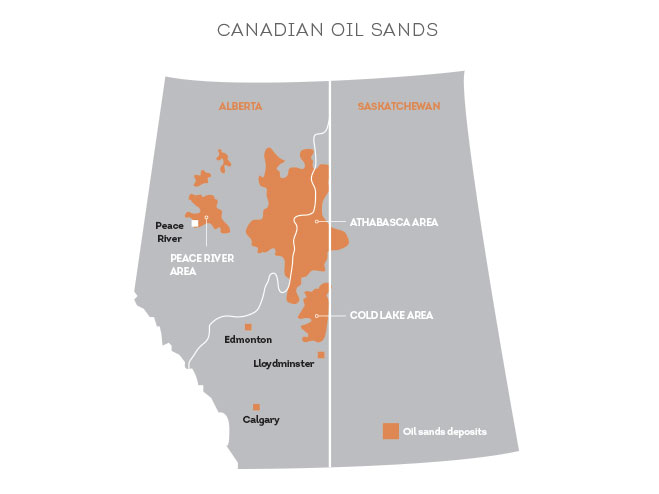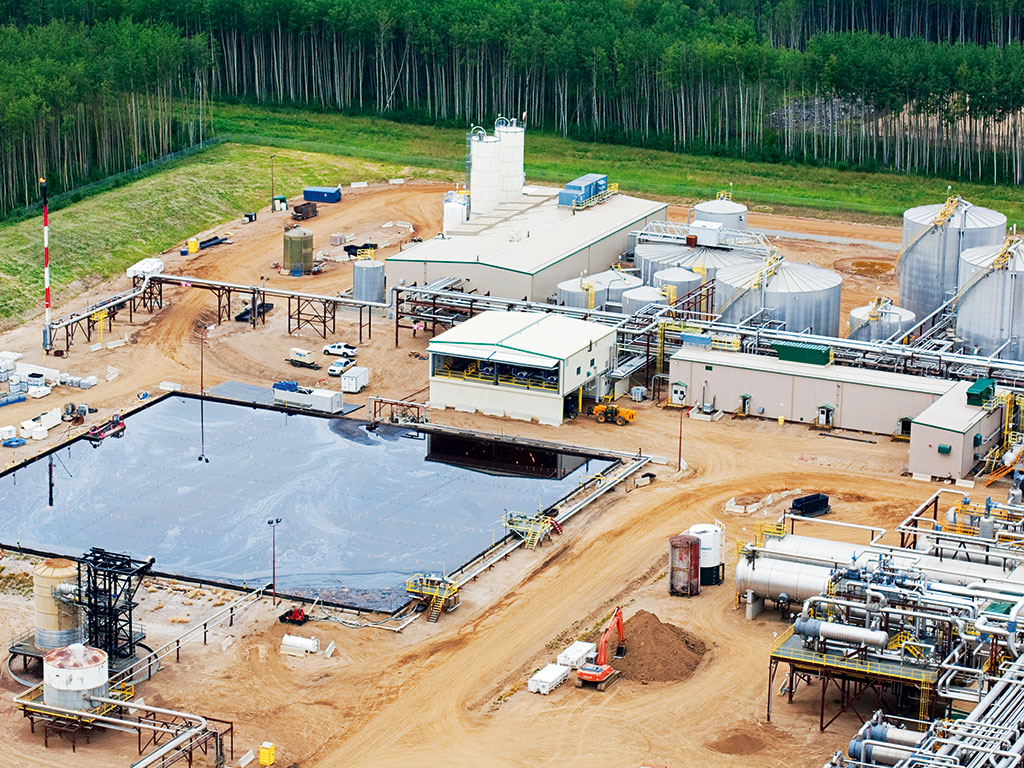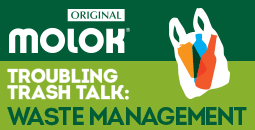Fuelling sustainability: Newalta cleans up in Canada
Newalta Corporation has been transforming the industrial waste management market one major customer at a time. Its most recent opportunity has been in Canada’s oil sands

Waste management company Newalta's onsite equipment in Canada's oil sands region
Newalta has become a leading provider of engineered environmental solutions that enable its customers to reduce disposal, enhance recycling and recover valuable resources from industrial residues. “From day one, we have been focused on finding smart, practical ways to recover value from what would otherwise be considered waste,” says Newalta President and Chief Executive Officer Alan Cadotte, a veteran of Canada’s industrial waste management market.
The company’s approach to managing industrial waste streams is considered unique in the marketplace as it focuses on maximising the hidden value of industrial waste through the recycling and recovery of marketable products. And when by-product recovery is not possible, the company finds ways to work onsite with its customers to reduce their waste streams at source.
“Conventional thinking revolves around the transportation and disposal of waste products, but for Newalta disposal is the last option after we’ve exhausted all the recovery and recycling options, and reduced the volume of waste as much as possible,” notes Cadotte.
Newalta’s growth
100
Employees in 1993
2,000
Employees in 2013
CAD 700m
Annual revenue
Improving sustainability
Newalta’s ability to assist companies in becoming environmental stewards – allowing them to meet or exceed growing regulatory requirements – has been key to its success. What began in 1993 as an oilfield and industrial services company – with six facilities, 100 employees and CAD 8m in revenue – has blossomed into an integrated network of facilities with 2,000 employees and a client-base that includes the oil and gas, mining, petrochemical, pulp and paper, refining and transportation sectors. Newalta now boasts annual revenues in the CAD 700m (£420m) range.
Cadotte notes that, over the past 20 years, Newalta has helped companies shrink their environmental footprints, while simultaneously reducing their costs: “With our focus on minimising waste and maximising the recovery of valuable products, and by ensuring our customers have access to the most advanced, efficient and cost-effective treatment alternatives, we are able to save our customers money and help them achieve environmental sustainability.”
This focus was enhanced even further as the company began identifying ways to apply technologies used within its facility network directly on customer sites. Customers responded positively to the cost savings and additional environmental benefits of this onsite services approach. And because of Newalta’s proven safety programme and exceptional performance, they have increasingly welcomed the company to bring its services onto their locations.
Canada’s energy challenge
With Canada’s oil sands located in northern Alberta, Newalta is near a market perfectly suited to the company’s approach. With global demand for energy expected to increase 40 percent by 2035, pundits maintain that oil will be a significant part of the energy mix. Canada has the third-largest oil reserves in the world at 174 billion barrels, with 169 billion of those barrels located in the Alberta oil sands.

While oil sands producers are viewed as the economic engine for the country, they also make it clear they want to continue producing oil in the most responsible way possible. This has led to them working with companies such as Newalta to help meet their sustainability objectives. “In the oil sands, this means we are focused on recovering the oil and water from the waste streams that the producers are creating,” says Cadotte.
For every barrel of oil produced in the oil sands, three barrels of water are needed. Water is a large component of both the Steam Assisted Gravity Drainage (SAGD) and mining extraction methods. While this could be a huge tax on local fresh water resources, oil sands producers are finding ways to reduce their fresh water usage.
While oil sands producers are viewed as the economic engine for the country, they also make it clear they want to continue producing oil in the most responsible way possible
In SAGD operations, steam is injected into the oil sands to increase the oil’s viscosity and get it out of the ground. A by-product of the process is a dense mixture of oil, water and solid impurities, or what’s called ‘slop oil’.
Newalta works on SAGD producers’ sites using centrifuges to separate the slop oil into its three main parts: oil, water and solids. Only the solids are sent to landfill for disposal and solids typically represent less than five percent of the original slop oil volume.
“We are able to dramatically reduce the amount of waste that these producers are sending offsite by recovering the oil and water at their operation,” says Cadotte. “Offsite trucking is reduced significantly, saving producers money, reducing the risk around traffic on roads and ultimately reducing greenhouse gas emissions.”
Newalta’s slop oil treatment process also means producers recover additional oil for market and can re-use most of the water. The oil Newalta recovers from the slop oil is sent back to the operation for final polishing before going into the producer’s sales tank. The water is treated for reuse, which means producers don’t have to use as much fresh water.
The challenge of tailings ponds
Newalta has been working with producers such as Suncor and Nexen on their SAGD operations for five years. The company’s success there led to discussions two years ago with other producers who primarily use mining extraction methods. These mining activities result in the creation of tailings ponds.
Tailings ponds are holding basins for water used in the mining extraction process in the oil sands. These are the ponds often associated with the oil sands in news reports on the region. “There is a major focus on reclaiming tailings ponds in the oil sands right now, driven by the producers’ objective to reduce the environmental impact of their operations and by new government regulations,” says Cadotte. “Tailings ponds are such a critical issue in the oil sands that producers are working together through industry associations to find solutions.”

In the mining process, producers use hot water to separate bitumen from the sand. This water and sand is then put into a tailings pond to allow the materials to separate – a process that can take up to 30 years. The tailings ponds separate into three phases: sand on the bottom, water on top and mature fine tailings (MFT) in the middle.
MFT contains a mixture of oil, water, clay and silt, and has the consistency of yogurt. The water on top is re-used, but the MFT presents a real challenge to producers. Newalta is one of the leading suppliers looking to help solve the MFT issue.
Large, sophisticated customers
Newalta is operating on oil sands mining sites with producers such as Syncrude and Shell, using large-bowl centrifuges to separate the clay, silt and water of the MFT. The recovered water is put back in the tailings pond and can be re-used in the extraction process, while the solids are processed and prepared for reclamation.
“The Newalta solution is reducing the size of tailings ponds and saving fresh water,” says Cadotte. “Based on the success we’ve had already, we’re confident that centrifugation can be a key solution to the MFT problem.”
Alberta’s oil sands output will more than double to 4.2 million barrels per day by 2025. To be as environmentally responsible as possible, producers will need to continue to find innovative solutions to many challenges, including water use.
“Major changes to the way waste is managed in the oil sands sector are just beginning,” says Cadotte. “Five years ago, slop oil was a waste material – today it has commercial value. Two years ago, tailings ponds were only going to grow – today, they are beginning to reduce in size.”
Canadian oil reserves
3rd
Largest in the world
174bn
Barrels
169bn
Barrels in the Alberta oil sands
Indicative of the success Newalta has enjoyed in the oil sands, and the value its customers place on the sustainability-enhancing services it provides, Newalta was named Supplier of the Year in back-to-back years by industry trade publications for the Alberta oil and gas and oil sands sectors. The company’s focus on innovative environmental solutions and strong customer service are clearly paying dividends.
Innovation remains key to success
Oil sands producers are continuously looking to improve their operations, and Newalta is already exploring new technologies that will allow producers to recycle even more water. The company recently signed a deal with research and development leader DuPont Canada to test a water processing technology in the oil sands. The technology removes solids from water and facilitates a higher level of water re-use for producers.
“Our customers want and need to reduce the amount of water they use,” says Cadotte. “And we will continue to find ways to provide the engineered environmental solutions they are looking for.” Cadotte credits Newalta’s engineers and technical staff with making its innovative waste-recovery processes possible.
“We search worldwide for processes and technologies to improve the solutions we deliver to our customers,” he says. “And by helping our customers achieve environmental sustainability and by continually finding better, more efficient ways to manage their waste streams, Newalta is doing its part in helping create a cleaner world.”













